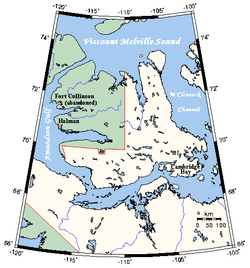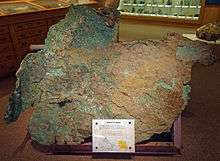Victoria Island (Canada)
 | |
 | |
| Geography | |
|---|---|
| Location | Northern Canada |
| Coordinates | 71°N 110°W / 71°N 110°WCoordinates: 71°N 110°W / 71°N 110°W |
| Archipelago | Canadian Arctic Archipelago |
| Area | 217,291 km2 (83,897 sq mi)[1] |
| Area rank | 8th |
| Length | 700 km (430 mi) |
| Width | 564–623 km (350–387 mi) |
| Highest elevation | 655 m (2,149 ft) |
| Highest point | Unnamed |
| Administration | |
| Territories |
Northwest Territories Nunavut |
| Largest settlement | Cambridge Bay, Nunavut (pop. 1,477) |
| Demographics | |
| Population | 1,875 (2006) |
| Ethnic groups | Inuit |
Victoria Island (or Kitlineq)[2][3] is an island in the Canadian Arctic Archipelago and straddles the boundary between Nunavut and the Northwest Territories of Canada. It is the eighth largest island in the world, and at 217,291 km2 (83,897 sq mi)1 is Canada's second largest island. It is nearly double the size of Newfoundland (111,390 km2 (43,008 sq mi)), and is slightly larger than the island of Great Britain (209,331 km2 (80,823 sq mi)). It contains the world's largest island within an island within an island.[4] The western third of the island belongs to the Inuvik Region in the Northwest Territories; the remainder is part of Nunavut's Kitikmeot Region.
History
In 1826 John Richardson saw the southwest coast and called it "Wollaston Land".[5] In 1839 Peter Warren Dease and Thomas Simpson followed its southeast coast and called it "Victoria Land".[6] A map published by John Barrow in 1846 shows a complete blank from these two lands north to "Banks Land" which is the north coast of Banks Island.[7] In 1851 John Rae charted its entire south coast and connected the two "lands".[8] In 1850 and 1851 Robert McClure circumnavigated most of Banks Island, thereby separating it from the rest of Victoria Land. His men also charted the northwest and west coasts of Victoria Island.[9] One of Roald Amundsen's men, Godfred Hansen, charted its east coast as far as Cape Nansen in 1905,[10] and in 1916 and 1917 Storker T. Storkerson, of Vilhjalmur Stefansson's Canadian Arctic Expedition, charted its northeast coast, discovering the Storkerson Peninsula.[11]
Location and description

Viscount Melville Soundmap1 lies to the north, and the M'Clintock Channelmap2 and Victoria Straitmap3 lie eastward. On the west are Amundsen Gulfmap4 and Banks Island,map5 which is separated from Victoria by a long sound called the Prince of Wales Strait.map6 To the south (from west to east) lies the Dolphin and Union Strait,map7 Austin Bay,map8 Coronation Gulfmap9 and the Dease Strait.map10
The southern waterways, and sometimes the Prince of Wales Strait, form part of the disputed Northwest Passage which the Government of Canada claims are Canadian Internal Waters, while other nations state they are either territorial waters or international waters.
Victoria Island is an island of peninsulas, having a heavily indented coastline with many inlets. In the east, pointing northwards, is the Storkerson Peninsula,map11 which ends with the Goldsmith Channel,map12 the body of water separating Victoria from Stefansson Island.map13 The Storkerson Peninsula is separated from the island's north-central areas by Hadley Bay,map14 a major inlet. Another, broad peninsula is found in the north, Prince Albert Peninsula.map15 This ends at the Prince of Wales Strait. In the south, and pointing westwards, is the Wollaston Peninsula,map16 separated from the island's central areas by Prince Albert Sound. The island as a whole coincidentally resembles a stylized maple leaf, the main Canadian symbol.
The highest point of Victoria Island is 655 m (2,149 ft) in the Shaler Mountainsmap17 in the north-central region. Located in the southeast, just north of Cambridge Bay is Ferguson Lakemap18 with an area of 562 km2 (217 sq mi) is the largest lake on the island.[12]
The island is named after Queen Victoria, the Canadian sovereign from 1867 to 1901. The features bearing the name "Prince Albert" are named after her consort.
There is also a smaller Victoria Island in Nunavut, located in Amadjuak Lake on Baffin Island.[13]
The Dolphin-Union Caribou herd locally known as Island Caribou,[14][15] are a migratory population of barren-ground caribou, Rangifer tarandus groenlandicus, that occupy Victoria Island in Canada's High Arctic and the nearby mainland. They are endemic to Canada. They migrate across the Dolphin and Union Strait from their summer grazing on Victoria Island to their winter grazing area on the Nunavut-NWT mainland in Canada.[14][16] It is unusual for North American caribou to seasonally cross sea ice and the only other caribou to do so are the Peary caribou who are smaller in size and population.
Demographics
In the Canada 2006 Census the population of the island was 1,875; 1,477 in Nunavut and 398 in the Northwest Territories. Of the two settlements on the island the largest is Cambridge Bay,map19 which lies on the south-east coast and is in Nunavut. Ulukhaktokmap20 is on the west coast and is in the Northwest Territories. Trading posts, such as Fort Collinsonmap21 on the northwest coast, have long since been abandoned.
Notes
- ^1 The United Nations Environment Programme says that Victoria Island has an area of 220,548 km2 (85,154 sq mi).[17] However, the Atlas of Canada indicates the island is 217,291 km2 (83,897 sq mi).[1]
Maps


- ^map1 Viscount Melville Sound - 74°N 108°W / 74°N 108°W
- ^map2 M'Clintock Channel - 72°N 102°W / 72°N 102°W
- ^map3 Victoria Strait - 69°N 101°W / 69°N 101°W
- ^map4 Amundsen Gulf - 70°N 120°W / 70°N 120°W
- ^map5 Banks Island - 73°N 121°W / 73°N 121°W
- ^map6 Prince of Wales Strait - 72°20′N 119°00′W / 72.333°N 119.000°W
- ^map7 Dolphin and Union Strait - 69°08′N 116°00′W / 69.133°N 116.000°W
- ^map8 Austin Bay - 68°31′N 113°06′W / 68.517°N 113.100°W
- ^map9 Coronation Gulf - 68°N 112°W / 68°N 112°W
- ^map10 Dease Strait - 68°50′N 107°30′W / 68.833°N 107.500°W
- ^map11 Storkerson Peninsula - 72°30′N 106°30′W / 72.500°N 106.500°W
- ^map12 Goldsmith Channel - 73°13′N 106°12′W / 73.217°N 106.200°W
- ^map13 Stefansson Island - 73°30′N 105°30′W / 73.500°N 105.500°W
- ^map14 Hadley Bay - 72°31′N 108°12′W / 72.517°N 108.200°W
- ^map15 Prince Albert Peninsula - 72°30′N 116°00′W / 72.500°N 116.000°W
- ^map16 Wollaston Peninsula - 69°45′N 114°30′W / 69.750°N 114.500°W
- ^map17 Shaler Mountains - 72°18′N 109°44′W / 72.300°N 109.733°W
- ^map18 Ferguson Lake - 69°25′N 105°15′W / 69.417°N 105.250°W
- ^map19 Cambridge Bay - 69°07′N 105°03′W / 69.117°N 105.050°W
- ^map20 Ulukhaktok - 70°44′N 117°46′W / 70.733°N 117.767°W
- ^map21 Fort Collinson - 71°37′N 117°52′W / 71.617°N 117.867°W
See also
- Parker's Notch
- Prince Albert Impact Crater (72°28′N 113°56′W)
References
- 1 2 "Atlas of Canada". Atlas.nrcan.gc.ca. 2009-08-12. Archived from the original on 2013-01-22. Retrieved 2010-08-30.
- ↑ "Society-COPPER-ESKIMO". ukc.ac.uk. Retrieved 2008-11-01.
- ↑ Swann, Brian (2005). Wearing the Morning Star: Native American Song-Poems. Lincoln, NE: U of Nebraska Press. p. 133. ISBN 0-8032-9340-2.
- ↑ Wolchover, Natalie (January 24, 2012). "World's Largest Island-in-a-lake-on-an-island-in-a-lake-on-an-island Seen on Google Earth". LiveScience. Retrieved September 15, 2013.
- ↑ Franklin, John (1828). Narrative of a second expedition to the shores of the Polar sea in the years 1825, 1826 and 1827, by John Franklin,... including an account of the progress of a detachment to the Eastward, by John Richardson. London: J. Murray.
- ↑ Simpson, Thomas (1843). Narrative of the discoveries on the north coast of America: effected by the officers of the Hudson's Bay Company during the years 1836-39. London: R. Bentley.
- ↑ Derek Hayes,"Historical Atlas of the Arctic", map 136
- ↑ McGoogan, Kenneth (2003). Fatal passage: the true story of John Rae, the Arctic hero time forgot. New York: Carroll & Graf Publishers.
- ↑ McClure, Robert (1856). Osborn, Sherard, ed. The Discovery of the North-West Passage. London: Longman, Brown, Green, Longmans, & Roberts.
- ↑ Amundsen, Roald and Godfred Hansen (1908). Roald Amundsen’s "The North West Passage"; being the record of a voyage of exploration of the ship "Gjøa" 1903-1907. London: A Constable and Co.
- ↑ Stefansson, Vilhjalmur (1922). The Friendly Arctic: The Story of Five Years in Polar Regions. New York: Macmillan.
- ↑ Ferguson Lake at the Atlas of Canada
- ↑ Victoria Island, Amadjuak Lake at the Atlas of Canada
- 1 2 GNWT, Species at Risk in the Northwest Territories 2012 (PDF), Government of Northwest Territories, Department of Environment and Natural Resources, ISBN 978-0-7708-0196-0, retrieved 31 October 2014
- ↑ "COSEWIC Assessment and Update Status Report on the Peary Caribou Rangifer tarandus pearyi and Barren-ground Caribou Rangifer tarandus groenlandicus Dolphin and Union population in Canada" (PDF), COSEWIC, May 2004, ISBN 0-662-37375-8, retrieved 1 November 2014
- ↑ Poole, Kim G.; Patterson, Brent R.; Dumond, Mathieu (December 2010), "Sea Ice and Migration of the Dolphin and Union Caribou Herd in the Canadian Arctic: An Uncertain Future" (PDF), Arctic, 63 (4): 414–428, doi:10.14430/arctic3331, retrieved 31 October 2014
- ↑ Victoria Island at the UNEP
Further reading
- Geological Survey of Canada, J. G. Fyles, D. A. Hodgson, and J. Bednarski. Quaternary Geology of Wynniatt Bay, Victoria Island, Northwest Territories. Open file (Geological Survey of Canada), 2718. 1988.
- Geological Survey of Canada, R. H. Rainbird, A. N. LeCheminant, and I. Lawyer. Geology, Duke of York Inlier, Victoria Island, Northwest Territories. Open file (Geological Survey of Canada), 3304. 1997.
- Geological Survey of Canada, D. A. Hodgson, and J. Bednarski. Preliminary Suficial Materials of Kagloryuak River (77F) and Burns Lake (77G), Victoria Island, Northwest Territories. Open file (Geological Survey of Canada), 2883. 1994.
- Gyselman, E. C., and L. K. Gould. Data on Amphidromous and Freshwater Fish from Central Victoria Island and Freshwater Systems Draining into Melville Sound and Elu Inlet, N.W.T., Canada. Winnipeg: Dept. of Fisheries and Oceans, 1992.
- Jakimchuk, R. D., and D. R. Carruthers. Caribou and Muskoxen on Victoria Island, N.W.T. Sidney, B.C.: R.D. Jakimchuk Management Associates Ltd, 1980.
- McGhee, Robert. An Archaeological Survey of Western Victoria Island, N.W.T., Canada. Ottawa, Ont: National Museums of Canada, 1971.
- Parmelee, David Freeland, H. A. Stephens, and Richard H. Schmidt. The Birds of Southeastern Victoria Island and Adjacent Small Islands. Ottawa: [Queen's Printer], 1967.
- Peterson, E. B., R. D. Kabzems, and V. M. Levson. Terrain and Vegetation Along the Victoria Island Portion of a Polar Gas Combined Pipeline System. Sidney, B.C.: Western Ecological Services, 1981.
- Rainbird, Robert H. Stratigraphy, Sedimentology and Tectonic Setting of the Upper Shaler Group, Victoria Island, Northwest Territories. Ottawa: National Library of Canada = Bibliothèque nationale du Canada, 1991. ISBN 0-315-66301-4
- Washburn, A. L. Reconnaissance Geology of Portions of Victoria Island and Adjacent Regions, Arctic Canada. [New York]: Geological Society of America, 1947.
External links
| Wikimedia Commons has media related to Victoria Island, Canada. |
- Map of Victoria Island at the Atlas of Canada
- Victoria Island Expedition